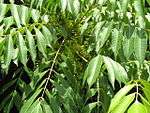Toxicodendron succedaneum
Toxicodendron succedaneum, the wax tree,[1] Japanese Hazenoki tree (Sumac or wax tree) or sơn in Vietnam, is a flowering plant species in the genus Toxicodendron found in Asia, although it has been planted elsewhere, most notably Australia and New Zealand. It is a large shrub or tree, up to 8 m tall, somewhat similar to a sumac tree. Because of its beautiful autumn foliage, it has been planted outside Asia as an ornamental plant, often by gardeners who were apparently unaware of the dangers of allergic reactions. It is now officially classified as a noxious weed in Australia and New Zealand. It is one of the city tree symbols of Kurume, Fukuoka, Japan.
| Toxicodendron succedaneum | |
|---|---|
 | |
| Köhler's Medicinal Plants plate 272 | |
| Scientific classification | |
| Kingdom: | Plantae |
| Clade: | Tracheophytes |
| Clade: | Angiosperms |
| Clade: | Eudicots |
| Clade: | Rosids |
| Order: | Sapindales |
| Family: | Anacardiaceae |
| Genus: | Toxicodendron |
| Species: | T. succedaneum |
| Binomial name | |
| Toxicodendron succedaneum | |
| Synonyms | |
|
Rhus succedanea L. | |
The larvae of the moths Eteoryctis deversa, Caloptilia aurifasciata, Caloptilia protiella, Caloptilia rhois and Callidrepana patrana feed on T. succedaneum.
Chemistry
The plant produces hinokiflavone, a cytotoxic biflavonoid.[2] Its stems are also a commercial source of fisetin, extracted in China.[3]
Uses
It is used to produce lacquer. In Vietnam, the lacquer is used to produce lacquer paintings, known as sơn mài, from resin of the tree.
In East Asia, in particular in Japan, traditional candle fuel (also called Japan wax) was produced, among other sumac plants, from Toxicodendron succedaneum crushed fruits rather than beeswax or animal fats. Japan wax is a byproduct of lacquer manufacture. It is not a true wax but a fat that contains 10–15% palmitin, stearin, and olein with about 1% japanic acid (1,21-heneicosanedioic acid). Japan wax is sold in flat squares or disks and has a rancid odor. It is extracted by expression and heat, or by the action of solvents. The fatty-acid methyl ester of the kernel oil meets all of the major biodiesel requirements in the USA (ASTM D 6751-02, ASTM PS 121-99), Germany (DIN V 51606) and European Union (EN 14214).[4]
It is used as a medicinal plant in India.
The fruits are edible though their consumption is not recommended because of the general toxicity of the plant.
Images gallery
 Wood sample at Jardim Botânico, São Paulo, Brazil
Wood sample at Jardim Botânico, São Paulo, Brazil Leaves and flowers
Leaves and flowers Bark
Bark A very common wild tree in Hong Kong
A very common wild tree in Hong Kong Detail of flowers
Detail of flowers
References
- "Toxicodendron succedaneum". Natural Resources Conservation Service PLANTS Database. USDA. Retrieved 11 December 2015.
- Lin, YM; Chen, FC; Lee, KH (1989). "Hinokiflavone, a cytotoxic principle from Rhus succedanea and the cytotoxicity of the related biflavonoids". Planta Medica. 55 (2): 166–8. doi:10.1055/s-2006-961914. PMID 2526343.
- Gábor, M.; Eperjessy, E. (1966). "Antibacterial Effect of Fisetin and Fisetinidin". Nature. 212 (5067): 1273. doi:10.1038/2121273a0. PMID 21090477.
- Mohibbeazam, M; Waris, A; Nahar, N (2005). "Prospects and potential of fatty acid methyl esters of some non-traditional seed oils for use as biodiesel in India". Biomass and Bioenergy. 29 (4): 293–302. doi:10.1016/j.biombioe.2005.05.001.
External links
![]()